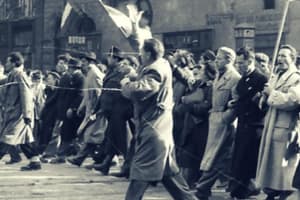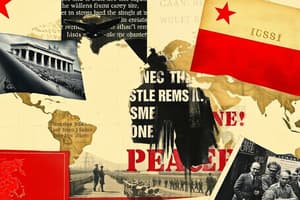Podcast
Questions and Answers
What was Mátyás Rákosi's vision for Hungary?
What was Mátyás Rákosi's vision for Hungary?
- A country of technological innovation
- A country of iron and steel (correct)
- A country focused on agriculture
- A country famous for its tourism
Hungary's secret police used water cannons to disperse protestors during the demonstrations in October 1956.
Hungary's secret police used water cannons to disperse protestors during the demonstrations in October 1956.
False (B)
Who was the leader that replaced Mátyás Rákosi during the unrest in Hungary?
Who was the leader that replaced Mátyás Rákosi during the unrest in Hungary?
Imre Nagy
The Hungarian Communist government requested military support from the _____ during the protests.
The Hungarian Communist government requested military support from the _____ during the protests.
Match the events or leaders to their descriptions:
Match the events or leaders to their descriptions:
What event marked the resignation of President Husák in Czechoslovakia?
What event marked the resignation of President Husák in Czechoslovakia?
The Velvet Revolution was characterized by violent repression of protests.
The Velvet Revolution was characterized by violent repression of protests.
What was the outcome of the protests that began in Romania on December 21, 1989?
What was the outcome of the protests that began in Romania on December 21, 1989?
The __________ Revolution took place in Czechoslovakia in December 1989.
The __________ Revolution took place in Czechoslovakia in December 1989.
What was a significant result of the demonstrations in East Germany in November 1989?
What was a significant result of the demonstrations in East Germany in November 1989?
Match the following events with their corresponding countries:
Match the following events with their corresponding countries:
Petar Mladenov remained in power despite mass protests in Bulgaria.
Petar Mladenov remained in power despite mass protests in Bulgaria.
In which year did Slovenia vote to break away from Yugoslavia?
In which year did Slovenia vote to break away from Yugoslavia?
What was a significant reason Khrushchev could not accept Hungary's withdrawal from the Warsaw Pact?
What was a significant reason Khrushchev could not accept Hungary's withdrawal from the Warsaw Pact?
Khrushchev wanted more independent Communist states in Eastern Europe.
Khrushchev wanted more independent Communist states in Eastern Europe.
Who led Yugoslavia to break away from the influence of the USSR?
Who led Yugoslavia to break away from the influence of the USSR?
Khrushchev's response to the Hungarian Uprising was primarily motivated by his need to maintain __________ among the satellite states.
Khrushchev's response to the Hungarian Uprising was primarily motivated by his need to maintain __________ among the satellite states.
Which of the following statements is NOT true regarding Khrushchev's reaction to the protests in Hungary?
Which of the following statements is NOT true regarding Khrushchev's reaction to the protests in Hungary?
Yugoslavia became closer to the West by rejecting military support from NATO.
Yugoslavia became closer to the West by rejecting military support from NATO.
What impact did the protests in Hungary have on the perception of Communism in the West?
What impact did the protests in Hungary have on the perception of Communism in the West?
Match the following countries with their relationship to the USSR:
Match the following countries with their relationship to the USSR:
Flashcards
Rákosi's Iron and Steel Vision
Rákosi's Iron and Steel Vision
Mátyás Rákosi, a communist leader of Hungary, implemented strict control over the country. He aimed to transform Hungary into an industrial powerhouse, focusing on iron and steel production despite the lack of local iron ore resources.
Hungarian Student Protests
Hungarian Student Protests
In October 1956, students in Budapest led peaceful protests, demanding greater political and personal freedoms. However, their peaceful demonstrations were met with suppression by the Hungarian secret police, escalating the situation.
Hungary's Call for Soviet Intervention
Hungary's Call for Soviet Intervention
The Hungarian Communist government, facing escalating unrest and protests, sought assistance from the Soviet Union to regain control and suppress the uprising.
Khrushchev's Leadership Change
Khrushchev's Leadership Change
Signup and view all the flashcards
Nagy's Reforms
Nagy's Reforms
Signup and view all the flashcards
Khrushchev's initial concessions to Hungary
Khrushchev's initial concessions to Hungary
Signup and view all the flashcards
Khrushchev's opposition to Hungary's withdrawal from the Warsaw Pact
Khrushchev's opposition to Hungary's withdrawal from the Warsaw Pact
Signup and view all the flashcards
Khrushchev's fear of independent Communist states
Khrushchev's fear of independent Communist states
Signup and view all the flashcards
Khrushchev's suppression of the Hungarian Uprising
Khrushchev's suppression of the Hungarian Uprising
Signup and view all the flashcards
Causes of the Hungarian Uprising
Causes of the Hungarian Uprising
Signup and view all the flashcards
Consequences of the Hungarian Uprising
Consequences of the Hungarian Uprising
Signup and view all the flashcards
Significance of the Hungarian Uprising
Significance of the Hungarian Uprising
Signup and view all the flashcards
Khrushchev's Mixed Reaction to the Hungarian Uprising
Khrushchev's Mixed Reaction to the Hungarian Uprising
Signup and view all the flashcards
Solidarity Movement
Solidarity Movement
Signup and view all the flashcards
Fall of the Berlin Wall
Fall of the Berlin Wall
Signup and view all the flashcards
Velvet Revolution
Velvet Revolution
Signup and view all the flashcards
Romanian Revolution
Romanian Revolution
Signup and view all the flashcards
Bulgarian Revolution
Bulgarian Revolution
Signup and view all the flashcards
Breakup of Yugoslavia
Breakup of Yugoslavia
Signup and view all the flashcards
Warsaw Pact Collapse
Warsaw Pact Collapse
Signup and view all the flashcards
End of the USSR
End of the USSR
Signup and view all the flashcards
Study Notes
IGCSE History Study Notes
- This document contains a study guide on the security of the USSR's control over Eastern Europe from 1948-1989.
- It includes topics such as motivations and consequences of control in Eastern Europe, opposition to Soviet control in Hungary and Czechoslovakia, the building of the Berlin Wall in 1961, Solidarity in Poland, and Gorbachev's role.
- The content also features a timeline of key events, including dates and associated actions from 1940 to 1991
- Key figures include Joseph Stalin, Nikita Khrushchev, Leonid Brezhnev, Andropov, and Chernenko.
- The material discusses events such as the Hungarian Uprising, the Prague Spring, and the construction of the Berlin Wall.
- The documents' content highlights the socio-political and economic pressures influencing events.
Studying That Suits You
Use AI to generate personalized quizzes and flashcards to suit your learning preferences.




